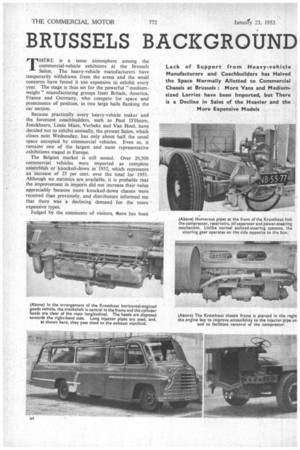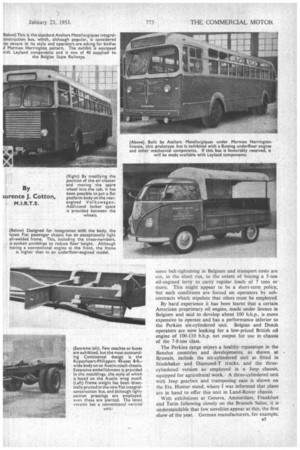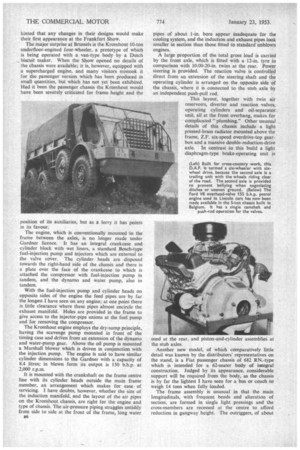BRUSSELS BACKGROUND
Page 38

Page 39

Page 40

Page 43

If you've noticed an error in this article please click here to report it so we can fix it.
THERE is a tense atmosphere among the commercial-vehicle exhibitors at the Brussels Salon. The heavy-vehicle manufacturers have temporarily withdrawn from the arena and the small concerns have found it too expensive to exhibit every year. The stage is thus set for the powerful " mediumweight " manufacturing groups from Britain, America, France and Germany, who compete for space and prominence of position, in two large halls flanking the car section.
Because practically every heavy-vehicle maker and . the foremost coachbuilders, such as Paul D'Heure, Jonckheere, Louis Maes, Verbeke and Van Hoot, have decided not to exhibit annually, the present Salon, which closes next Wednesday, has only about half the usual space occupied by commercial vehicles. Even so, it remains one of the largest and most representative exhibitions staged in Europe.
The Belgian market is still sound. Over 20,500 commercial vehicles were imported as complete assemblies or knocked-down in 1952, which represents an increase of 25 per cent. over the total for 1951. Although no statistics are available, it is probable that the improvement in imports did not increase their value appreciably because more knocked-down chassis were received than previously, and distributors informed me that there was a declining demand for the more • expensive types.
Judged by the comments of visitors, tkere has been Lack of Support from Heavy-vehicle Manufacturers and Coachbuilders has Halved the Space Normally Allotted to Commercial Chassis at Brussels : More Vans and Mediumsized Lorries have been Imported, but There is a Decline in Sales of the Heavier and the
some belt-tightening in Belgium and transport costs are cut, in the short run, to the extent of buying a 5-ton oil-engined lorry to carry regular loads of 7 tons or more. This might appear to be a short-term policy, but such conditions are forced on operators by subcontracts which stipulate that oilers must be employed.
By hard experience it has been learnt that a certain American proprietary oil engine, made under licence in Belgium and said to develop about 100 b.h.p., is more expensive to operate and has a performance inferior to the Perkins six-cylindered unit. Belgian and Dutch operators are now looking for a low-priced British oil engine of 100-110 b.h.p. net output for use in chassis of the 7-8-ton class.
The Perkins range enjoys a healthy reputation in the Benelux countries and developments, as shown at Brussels, include the six-cylindered unit as fitted in Studebaker and Diamond-T trucks, and the threecylindered version as employed in a Jeep chassis, equipped for agricultural work. A three-cylindered unit with Jeep gearbox and transposing case is shown on the Ets. Hunter stand, where I was informed that plans are in hand to offer this unit in Land-Rover chassis.
With exhibitions at Geneva, Amsterdam, Frankfurt and Turin following closely on the Brussels Salon, it is understandable that few novelties appear at this, the first show of the year. German manufacturers, for example. hinted that any changes in their designs would make their first appearance at the Frankfurt Show.
The major surprise at Brussels is the Kromhout 10-ton underfloor-engined four-wheeler, a prototype of which is being operated with a van-type body by a Dutch biscuit maker. When the Show opened no details of the chassis were available; it is, however, equipped with a supercharged engine, and many visitors mistook it for the passenger version which has been produced in small quantities, but which has not yet been exhibited. Had it been the passenger chassis the Kromhout would have been severely criticized for frame height and the
position of its auxiliaries, but as a lorry it has points in its favour.
The engine, which is conventionally mounted in the frame between the axles, is no longer made under Gardner licence. It has an integral crankcase and cylinder block with wet liners, a standard Bosch-type fuel-injection pump and injectors which are external to the valve cover. The cylinder heads are disposed towards the right-hand side of the chassis and there is a plate over the face of the crankcase to which is attached the compressor with fuel-injection pump in tandem, and the dynamo and water pump, also in tandem.
With the fuel-injection pump and cylinder heads on opposite sides of the engine the feed pipes are by far the longest I have seen on any engine; at one point there is little clearance where these pipes almost encircle the exhaust manifold. Holes are provided in the frame to give access to the injector-pipe unions at the fuel pump and for removing the compressor.
The Kromhout engine employs the dry-sump principle, having the scavenge pump mounted in front of the timing case and driVen from an extension of the dynamo and water-pump gear. Above the oil pump is mounted a Marshall blower which is driven in conjunction with the injection pump. The engine is said to have similar cylinder dimensions to the Gardner with a capacity of 8.4 litres; in blown form its output is 150 b.h.p. at 2,000 r.p.m.
It is mounted with the crankshaft on the frame centre line with its cylinder heads outside the main frame member, an arrangement which makes for ease • of servicing. I have doubts, however, whether the size of the induction manifold, and the layout of the air pipes on the Kromhout chassis, are right for the engine and type of chassis. The air-pressure piping straggles untidily from side to side at the front of the frame, long water B6 pipes of about 1-in, bore appear inadequate for the cooling system, and the induction and exhaust pipes look smaller in section than those fitted to standard unblown engines.
A large proportion of the total gross load is carried by the front axle, which is fitted with a 12-in. tyre in comparison with 10.00-20-in, twins at the rear. Power steering is provided. The reaction valve is controlled direct from an extension of the steering shaft and the operating cylinder is arranged on the opposite side of the chassis, where it is connected to the stub axle by an independent push-pull rod.
This layout, together with twin air reservoirs, diverter and reaction -valves, operating cylinders and oil-separator unit, all at the front overhang, makes for complicated "plumbing." Other unusual details of this chassis include a light pressed-brass radiator mounted above the frame, Z.F. six-speed overdrive-top gearbox and a massive double-reduction-drive axle. In contrast to this build a light diaphragm-type brake-operating unit is used at the rear, and piston-and-cylinder assemblies at the stub axles.
Another new model, of which comparatively little detail was known by the distributors' representatives on the stand, is a Fiat passenger chassis of 682 RN.-type which is intended for a 62-seater body of integral construction. Judged by its appearance, considerable support will be required from the body, as the chassis is by far the lightest I have seen for a bus or coach to weigh 14 tons when fully loaded.
The frame assembly is unusual in that the main longitudinals. with frequent bends and alteration of section, are formed in single light pressings and the cross-members are recessed at the centre to afford reduction in gangway height. The outriggers, of about 16 gauge sheet steel, are pierced for reduced weight and attached to the frame by welded gussets. The frame assembly is an all-welded structure.
If this model is to be operated at the maximum weight, 1 suggest that it will have a poor performance, because its six-cylindered oil engine of 6.56-litre capacity has an output of 92 b.h.p. at 2,000 r.p.m. which would afford approximately the same acceleration rate as the average fully laden six-wheeler. As an aid to improved performance it has an eight-speed main and auxiliary gearbox. Light alloys are used in the construction of the crankcase, gearbox and other parts, and the weight of the chassis is 4 tons 11 cwt.
There are no other completely new chassis on view apart from the cross-country vehicles exhibited by D.A.F. of Holland, some of which are to be made available for civilian use. One of the mysteries of the D.A.F. stand is a military vehicle, having eight wheels, which is described as a six-wheeler with six-wheel drive, Apparently, as the second pair of wheels is suspended above the others and has no drive under normal road conditions, the chassis qualifies as a six-wheeler: the suspended wheels are provided to prevent bellying under crosscountry conditions.
At £3,500 the purchaser gets value for his money because the transmission system appears to be most intricate. A bevel box, fitted at the rear of the auxiliary gearbox conveys the drive to shafts connected to independent overhead-worm drives at each of the six driven wheels. The first and second pair of wheels have torsion-bar suspension, and the third and fourth axles are linked by single springs pivoted at trunnions at the centre. From the arrangement of the drive to the rear axle, the articulation of the bogie would appear to be less than is provided in contemporary British models. Petrol engines, made under Hercules licence, are fitted in D.A.F. fourand six-wheel-drive chassis.
A six-cylindered overhead-valve petrol engine was shown on the Ford commercial vehicle stand at the 1952 Brussels Salon, and at the present Show a range of V.8. overhead-valve engines forms the surprise exhibit. Having a standard stroke of 88.9 mm. but varying in bore dimensions, the larger of these include a 4.572-litre unit of 145 b.h.p. output, and a 5.24-litre engine developing 155 b.h.p. In view of the economies being made in Belgium, there may be little demand for these larger units. Belgium is fast becoming biased towards the oil engine, and it may not be long before such units become common in most medium and heavy passenger vehicles, and in goods vehicles from 3-ton unladen weight upwards.
Ateliers Metallurgiques, a Belgian concern building integral-construction buses with Foden and Leyland components, is showing a new type of vehicle built on the Marmon-Herrington principle. Developed on American lines, it is more shapely and less austere in appearance than the normal Ateliers Metallurgigues product, but the outside is spoilt by most unsightly rivets, standing proud of the panels and joining strips by at least +-in.
Although the square shape has appealed in the past, operators are now demanding bodies of the Marmon-Herrington pattern and a prototype to be seen at Brussels has a Bussing 150 b.h.p. horizontal engine, and transmission components which will be offered as optional to standard Leyland units.
The Volkswagen van is reaping popularity because of its competitive price and low running cost. The position of the engine at the rear, coupled with the spare wheel which is mounted above it, has prevented a flat-platform body being fitted to the standard mass-produced product. A modified version, in which the engine air-cleaner is placed alongside the cylinders, and the spare wheel is mounted in the cab, has enabled a new truck-type platform body to be fitted. There is 2-cubic-yd. additional locker space between the conventional body floor and the new platform body.
Because practically all the Belgian coachbuiIding concerns are not participating in the Show there are few buses and coaches on display, but in the coach exhibits there is an Austin left-hand-drive long-wheelbase forward-control chassis with a Ruysschaert-Phillippart 40-seater body. As this coach is approximately 8-ft. wide there is noticeable side overhang, but the interior is spacious and luxuriously upholstered. This coach is built for long-distance touring having a roof rack for luggage at the rear, sliding head and glazed roof-panels.
























































































































































